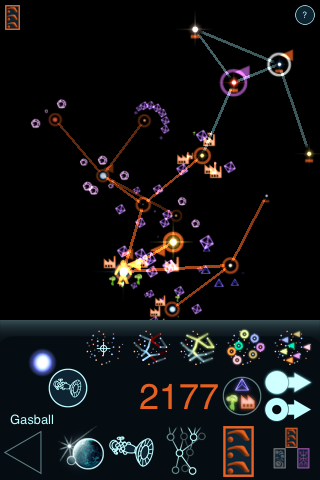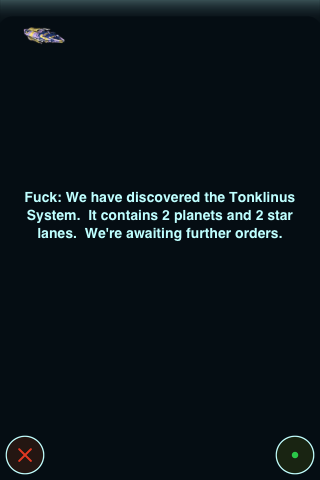
You can only imagine my joy when I learned that a true blue 4x game (explore, expand, exploit, exterminate – to expand the name into its full and most imperialistic definition) was available on the iOS platform. Even more so when it became apparent that the names behind it were the Logic Factory, the heads between Ascendancy back in 1996. Even more so when I realised that the game itself was Ascendancy, the coulda-shoulda-been hit game produced by the Logic Factory.
I played Ascendancy back in the day; circa 1996 it was one of a healthy number of space strategy games I spent an unhealthy amount of time with in between bouts of Masters of Orion and other similar space strategy titles. It’s a game I remember fondly, although it’s also a game I remember as being deeply flawed. My memory is equally flawed after fifteen years or so but I can say with some confidence that my major issues revolved around the later stages of the game: after fighting to win ahead of AI assaults and counter-attacking it quickly became apparent that the computer had little idea how to manage colonies efficiently – by which I mean it had no idea how to min/max its stats and little idea how to replace sub-optimal constructions with something better-suited to… well, any strategy whatsoever.
I don’t use the vile, overly mechanistic term min/max lightly; to me it’s a deeply cynical phrase which implies a loss of wonder toward the joy of videogames and a growing obsession with gaming systems. Never let it be said that I stand in the way of how people get their jollies, but to me fun has never been derived from optimising a spreadsheet. Nonetheless there are times when it becomes a sensible way to describe what one does with a strategy game: the best way to succeed can be to drill down to fine detail and prep one’s production facilities toward a specific purpose more specifically than an opponent has been programmed to do.
Regardless, fast forwards fifteen years to space year 2012 and my discovery that the fucking Logic Factory are republishing fucking Ascendancy on iOS. Of course I remember that shit! Try asking a hardcore arcade gamer if he remembers Missile Command. Obviously I bought the game immediately.

So began about four months of periodically remembering this potentially immense strategy game was on my iPod and trying to force myself to play it. It’s a shameful thing to say but I intended to review this game months ago and didn’t solely because I found it difficult to remember to actually play the damn thing. A game like Ascendancy is not a simple pick up and play title. You can blast through a few turns here and there, but will you remember your overall strategy? Will you fuck.
Yet on pass those four months and, eventually, here I am playing this game in every spare minute I have. Toilet breaks at work? Girlfriend going to the bar? Friend looks the other way for about thirty seconds? Get stuck in. It took four months but I’m hooked: the classic staples of 4x strategy have set their barbs deep. And oh boy do I dig those barbs.
Ascendancy is a classic 4x game, in that it throws at you the twin demands of planetary management (micro)Â alongside research and warfare (macro). Building up your planets is essential to achieve anything of significance. It’s also a task that betrays the age of the game; every last construction demands your action unless you set auto-manage to work – and as I already mentioned, the AI can’t build a colony for shit. An innovation that Ascendancy has boasted since 1996 is the auto turn-skip, which lets you fast-forward until something happens. In theory this is great, letting you hop forward 50 turns in a matter of seconds until a new piece of research is discovered or a fleet arrives where ordered. In practice, it means stopping every two turns to tell each colony in turn which building you want next. There’s no such thing as a build queue here, despite it being space year 2012.
In issues such as this the discrepancy between 2012 and 1996 is laid naked. Ascendancy is a strange game to lay it bare, too, as so many of what were once innovations lend themselves perfectly to the conventions of the modern age. The game’s starmaps and solar systems, once rendered in unnecessarily confusing 3D, are easy to spin around and zoom in this age of touchscreens in a way that was never true in the click/drag mouse and keyboard era. Equally, ordering twenty near-identical actions is not au fait today, and nor should it be: space combat is rendered exceptionally dull by the necessity of selecting each ship, weapon and command to open fire in turn.

Ultimately Ascendancy occupies uneasy territory. It does a superb job of taking an unusual and oft-forgotten cult classic into the modern era. It also makes the most of the unique characteristics of said cult classic to present the game as something modern. And really, there are no equivalent games within this genre and on this platform which can hold a candle to the depth, complexity  and playful whimsy of Ascendancy. However, the conventions of a genre now almost 15 years stale are almost impossible to ignore, and so it is difficult to argue that Ascendancy is a game with much appeal to anyone outside the narrow sector of iOS owners with a nostalgia for the golden age of 4x games.
But oh god, Logic Factory, do something more with this: the iOS platform is crying out for real strategy games and Ascendancy’s idiosyncratic setup and whimsical, unbalanced gadgets always offered the potential of something more than the staid statistical approach of other brilliant, genre-defining games, and even if it’s sixteen years too late this is a game with something unique to offer. Just don’t feel too constrained by the ultimately limited conventions of the stultifying past. At the end of the day the problems are the mechanics of user interface, not the vile imperial romance of weird stellar conquest.


Comments
2 responses to “Review: Ascendancy”
Like it, now if they released it on XBLIG I would play it.
To be honest I think it would be a nightmare to play using a controller. It pretty much demands the use of a mouse or sweaty digit. That said, I'm now thinking about ways they could manage it on some screens… there'd be an awful lot of scrolling and selecting but it could be done. So I guess the real question is, would the Logic Factory want to port their 16-year old code to XBLIG? At the moment they're still developing and improving the iOS version; even an Android port isn't yet in development. Sorry, droid fans!
As an aside: they are a small company and probably a one- or two-man operation at heart. Their company website is genuinely like something out of the 90s – none of it is written by marketing experts, the website is simple HTML, and alongside Ascendancy they're advertising a Kindle novel that I guess is written by one of them.